I love chasing Spanish mackerel, and coming from NSW that can sometimes prove a challenge. Queenslanders have them on tap for most of the year, and at times they can even be a pest up there when chasing other species! But for us southerners, it is often a waiting game, not merely for a fish to take your bait but for the fish to actually show up.
In the northern waters of New South Wales, one of the most eagerly awaited arrivals is the Spaniards, narrow-barred, snook or spotties. Call them what you like, they come in many names and sizes but one thing is for sure, they are popular.
The sad thing is they don’t travel all the way down the NSW coast, with their southern most reliable point being about Port Macquarie. Some years, if the currents are favourable, a lump of fish may come down as far as Sydney – usually spotted Spanish mackerel. Sometimes the odd narrow-barred mackerel has even been caught as far south as Jervis Bay, but these are occasional and sporadic at best.
From Port Macquarie north, they can be relied upon each year to show up when the water gets hot and the current runs hard.
They are a communal fish that travel in schools often in their thousands, that can show up one day and be gone the next, only to be further up or down the coast. They do frequent favoured reefs on an annual basis, but for the most part, when they find a good food supply they will stay in the same place for as long as the food lasts. They’re like the backpackers of the fish world.
The good thing about mackerel is that you generally don’t have to travel too far to sea to tangle with them. Unlike their cousin the wahoo that loves the open ocean, mackerel travel and feed along the inshore coastal reefs, islands and bommies – anywhere they can find baitfish.
During their travels they pass close to the deeper rocky headlands and breakwalls as well. As you can see, mackerel are not just the offshore anglers’ targets but land-based anglers can get in on the mack action as well. Each year they sweat on the arrival of the mackerel, as a land-based mackerel is no easy feat.
They first show up off the Tweed, often in early January and the 9-Mile Reef is a noted hotspot in this area. Depending on the currents, they then move down the coast with speed moving south from reef to reef.
They gather over the reefs off Byron Bay, Ballina and Evans Head before hitting Yamba with Woody Head and the Bluff good places to look while the Breakwall at Iluka has produced some big fish for the shore-based anglers over the years.
Brooms Head and the Sandon River have plenty of good reefs that seem to produce fish from early in the summer to late winter most seasons. Next they hit the Solitary Islands and Coffs Harbour area – one of the most popular areas to chase Spanish. Specific spots are endless due to the magnificent reef systems, bommies and islands all along the coast. Many of the headlands in this area are popular for land-based anglers with the Coffs Harbour Breakwalls a standout.
Sawtell and the reefs off Nambucca and Scotts Head are always worth a look before one of the most productive and popular areas along the coast, the reefs off Grassy Head and South West Rocks.
When they are on the bite, there can be up to 50 boats working the area and all catching fish. Grassy Head headland itself, while not that deep produces some good land-based fishing as well.
The next spot is the legendary Hat Head, where you need the combination of current and bait to catch fish. Whenthe stars align the fishing can be exceptional.
Hat and Hungry heads are both very popular land-based spots that have produced many great fish over the years.
Crescent Head doesn’t produce that many fish, probably due to the lack of launching facilities and land-based access, but just down the coast at Point Plomer anglers catch heaps and that is where the mackeral run seems to stop, with a few fish taken around Port Macquarie.
From around late January through to late April, you would expect to have a good chance of a mackerel around any of these places. It just depends whether you want to rough it and launch off the beaches and small creeks, or fish out of the more populated areas with better facilities.
For accurate GPS marks in all areas, just look up the numerous web sites, everyone has their own special spot. Not so special once it goes on the web, but they can be handy.
Being a predator up near the top of the food chain, they eat all the standard baitfish from pilchards to small tuna, it just depends on what you want to catch and how big. Pilchards, garfish, yellowtail, slimy mackerel, pike, trevally, bonito, frigate mackerel, mac tuna and striped tuna will all work well in different situations.
While slimy mackerel are a top bait for both species, there are other stand out baits. Striped sea pike are one of the best baits both alive or rigged dead, they just can’t swim past them and the humble tailor is one of the better baits for big narrow-barred, particularly off the rocks. If you are chasing spotties, then slimies and pilchards will do the trick, but if it’s big fish you want, there are plenty of big baits.
Live mackerel tuna, bonito and striped tuna are hard for big mackerel to pass up and a 25kg Spanish will make short work of a 3kg striped tuna.
Keeping this in mind there are a lot of lures out there that will catch Spanish, but the further south you get the more finicky they become to the point that south of Coffs Harbour they can be a real challenge.
Off the rocks the big flashy chrome slices, big poppers and minnow type lures are the mainstay while trolling out in the boat if bait is impossible to get. The big diving minnows are a standout with bibless minnows a close second.
Rigged dead baits like garfish are always preferred before trying lures, and can at times be more deadly than live baits.
Dead rigged small bonito and mackerel tuna are killers on the bigger fish.
Rule number one: wire is a must. I usually use a single strand of varying strength and thickness depending on where I’m fishing. You can use multi-strand, but it usually only lasts one fish or even one strike before it kinks and twists beyond repair.
You won’t catch many Spanish without wire, but you may fluke one from time to time. I managed one on a single 3/0 that ate a pike I was bringing in right at the back of the boat. It was 24kg and subdued on 6kg line – sometimes you get lucky. The other 5,000 unexpected bite offs were the norm.
That fish was taken on a snapper rated threadline rod, but for the bigger fish, light game tackle from 8-15kg is much easier and you can still get a good fight. Anything heavier is probably overkill.
For the spotties, a light threadline outfit or bait caster will do the job as a very big spotty would be 10kg, with 3-6kg the average. As always, the finer the line, the more strikes you will get, that goes for the wire too. Use the lightest you can, at times down to 6kg wire and 2kg line for really fussy spotties, and even then they may shy away. They can be very frustrating at their southern limits.
Hook sizes should be dictated by the bait you use and the size of the fish you chase. As always, make sure that your hooks are deadly sharp as they have hard mouths full of teeth and they love to shake their head violently to rid themselves of the hook, so getting them to stay on can be difficult.
The other crucial requirement is that your reel’s drag system must be silky smooth, as mackerel hit the bait at warp speed and don’t slow down when hooked. This first run is what they are renowned for and will find any chinks in a lumpy drag. They eventually slow with constant pressure and have a few more good runs in them, before they throw in the towel.
They are not like kingfish or trevally in the slugging department, so unless they are very large fish on lighter tackle the fight is not usually extended.
Mackerel respond to so many different methods, but as always you must target your species for best results and while spotted and narrow-barred are similar, the spotties don’t grow to nearly the size of the narrow barred, so you must scale your baits and tackle down to suit. Narrow-barred mackerel don’t always play to the rules though, and will grab a small bait fished for spotties – this is where the fun begins.
The most popular method to catch spotties is to anchor down on your chosen reef, put out a live bait and berley while fishing an unweighted pilchard down the berley trail. It’s pretty simple really.
Cubing with cut pilchard pieces will often bring the spotties right up to the back of the boat where you can see them grab your bait as you drift it back down the trail. Cubes of fresh tuna are even better.
Live baits can be fished with or without a float, but if you use slimy mackerel, I recommended a float as the little buggers swim all over the place and with a float you can keep an eye on where they are and adjust accordingly. A slimy mackerel, yellowtail or any live bait put out in mackerel country is a very nervous creature.
Slow troll live or rigged baits over your desired spots, particularly if the fish are spread out or moving around – take your pick.
For the bigger narrow-barred, larger baits are successful both live and rigged dead. Garfish in XOS sizes are effective, and small tuna exceptional, and if there are any fish about they rarely miss.
Like most fishing, the hours just prior to sunrise and sunset are prime times and this especially rings true with mackerel. During the day, they will often lay up into the current just off the bottom and sit there. You will see them on the sounder and when this happens, a down rigged bait will at times tempt them. The rest of the time they will amble about and you will see them slowly swimming in the berley trail or near the boat. They don’t swim fast all the time.
When the sun is low in the sky they really switch on to hunting mode, particularly during the evenings and some sizzling bites happen at this time.
When they make up their mind that they want something, they hit fast and hard and rarely miss their target, but you will miss many fish if you don’t have at least two hooks in the bait. I have seen pros rig with up to five big trebles in a bonito or frigate mackerel and even then they sometimes miss.
There are a thousand articles and books on rigs for live and dead baits, so a little homework on several will not go astray if you are chasing Spanish mackerel.
Asking the locals or the local tackle shop is always a good way to get the heads up on any location and buying something at the shop or a beer with the locals always helps.
When you do manage to catch one and get it in the boat, dispatch it quickly as a thrashing mackerel is a very dangerous thing.
The pointy end has razor sharp teeth that can inflict more than a nasty wound.
Place it on ice as the flesh is just too good to get warm.
Ciguatera poisoning can sometimes be a result of eating an affected mackerel, and south of the border this is rare, but does happen. As a general rule, fish under 10kg are usually a pretty safe bet.
Armed with this information, you may soldier forth and crack that first Spanish.
Once you do, you will get mackerel fever and always crave one more.
Reads: 3921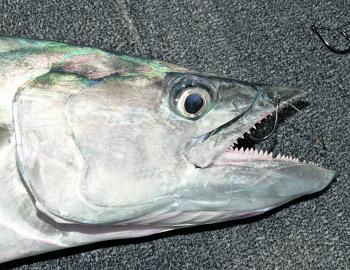
This is why you need wire; the sharp end of a spotty mackerel.
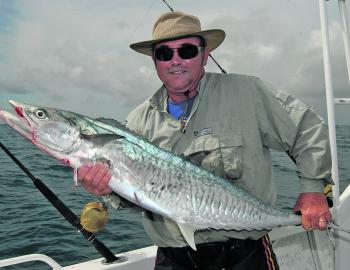
Sometimes spotties take big baits meant for bigger fish.

A striped pike brought this one undone – Spanish just love them.

This mackerel was picked up on a downrigger over sand when things had shut down.

Thread line gear is adequate to handle fish up to about 15kg.
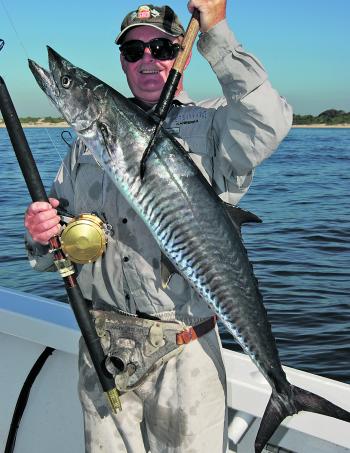
Travis with another mackerel from Grassy Head, which can get busy when they are on the bite.
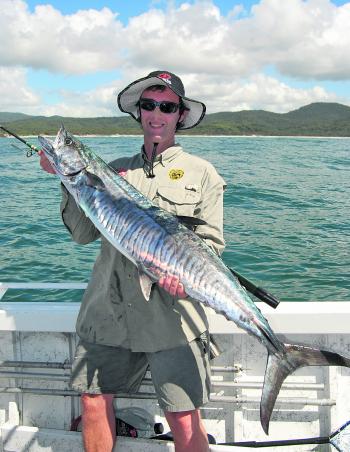
One from the archives: A slab of a mackerel taken on light gear. It emptied the spool on the first run and was totally unexpected.

The razor gang with heads and teeth like this they are the wolves of the sea.
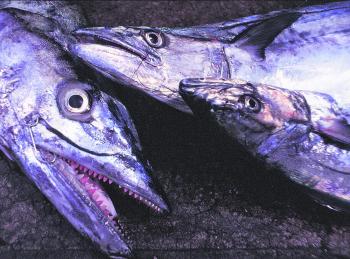
This ripper 20kg+ fish was taken on a live garfish from Iluka Breakwall on 10kg tackle.
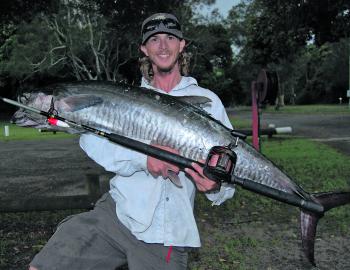
If they are there, Geoff will catch them, either off the rocks or from the boat. Here is another victim.
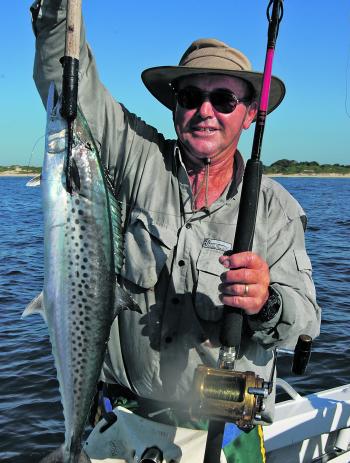
Another Grassy Head Spanish, you never get tired of that first run.




